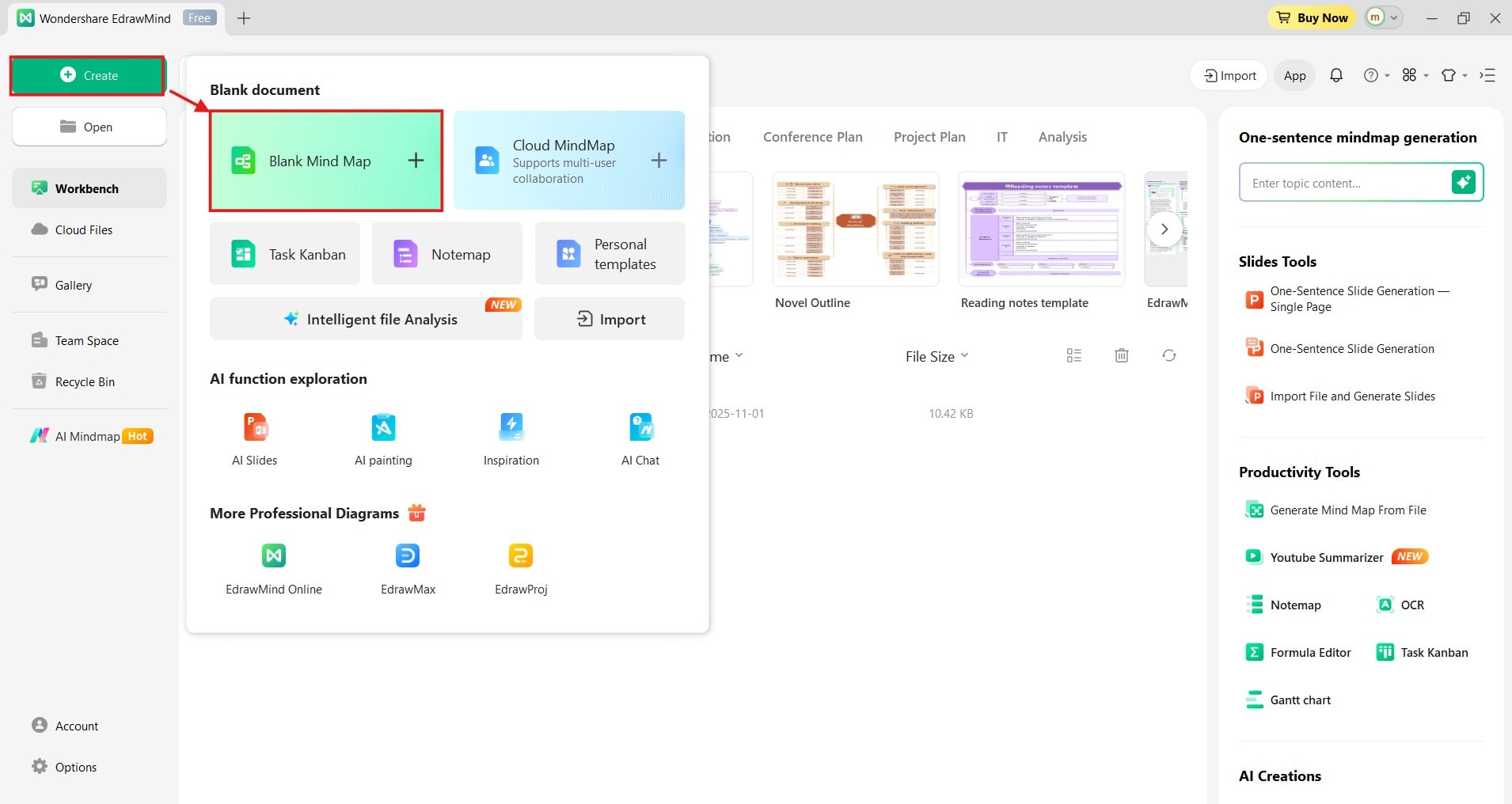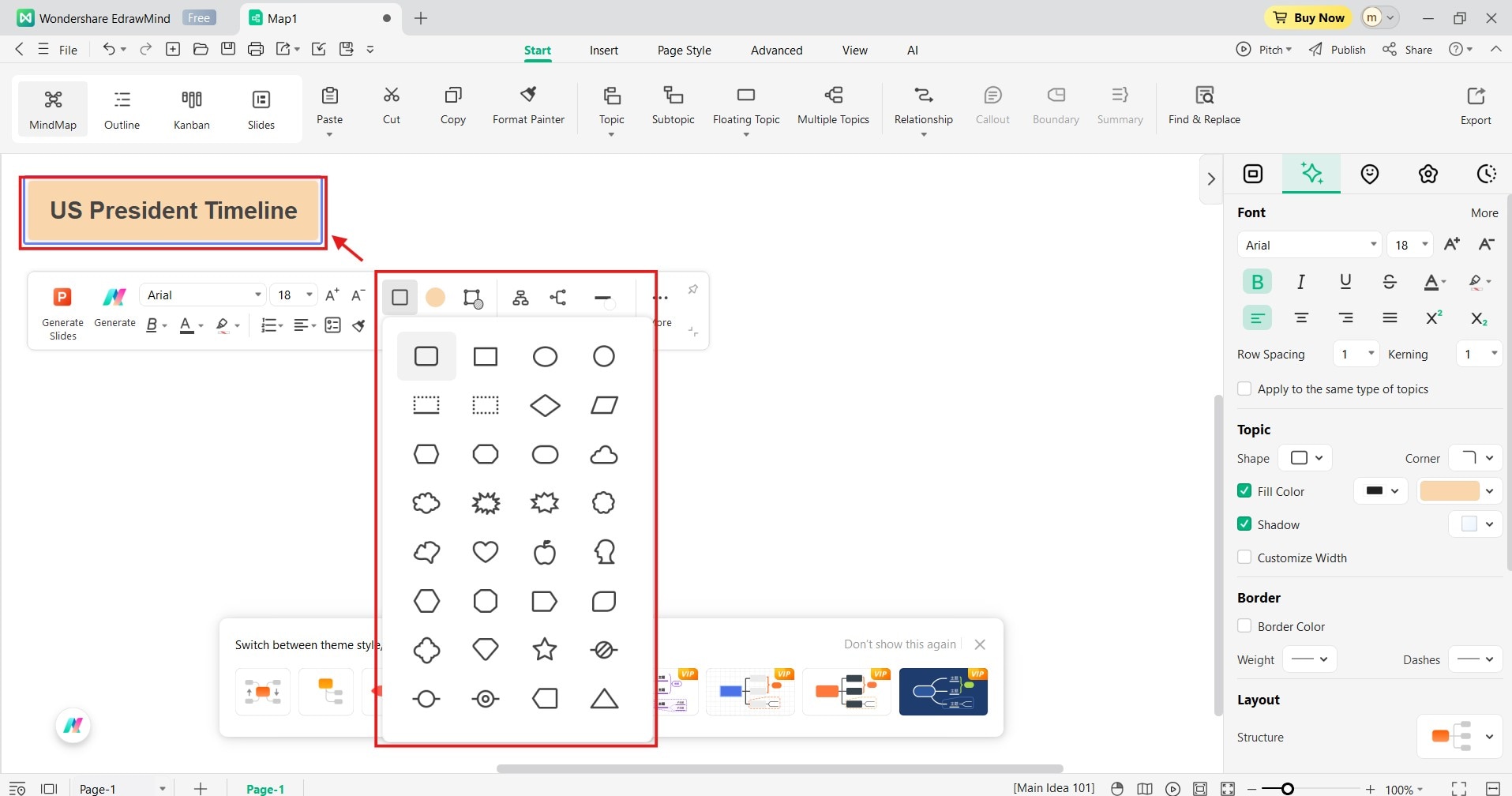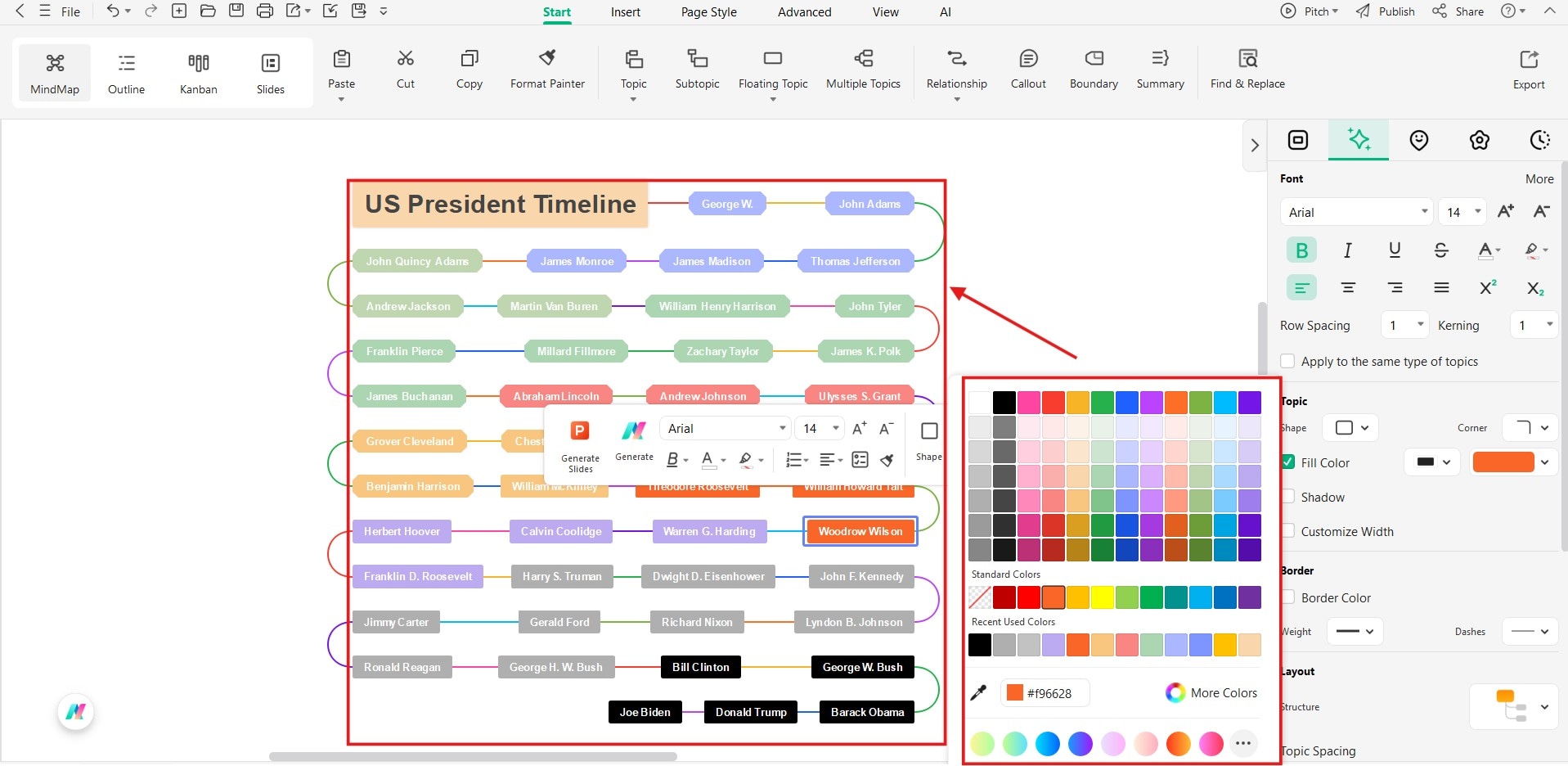Each leader builds on the last, shifting power, changing the country’s role in the world, and facing crises both external and internal. From the founding of a republic under George Washington to today’s digital and globalised demands under Trump again, we see patterns: war, scandal, reform, and resurgence.
This chronology of US presidents isn’t just a list of names, but a journey through over two centuries of leadership, ambition, and the ever-evolving American dream. All this started from the courage of Washington, shifted to the vision of Roosevelt, the optimism of Kennedy, and the resilience of Obama. Let’s have an insider’s look at the complete US president timeline to know each era in detail.
In this article
US President Timeline
The story of the United States is deeply connected to the leaders who have shaped it. Since George Washington took office in 1789, each president has faced many challenges, made bold decisions, and left a mark on the nation’s history.
From the early struggles of a new republic to global leadership in the modern world, the presidency has truly evolved alongside America itself. Be it wars, economic changes, social movements, or technological revolutions, each has brought new tests and transformations.
From Washington to today, see how every leader helped define the country’s path and shaped the United States into what it is now.
- 1) George Washington (1789-1797)
America’s first president and the man who set the standard for all who followed, Washington led a brand-new country right after the Revolution, built a functioning government, and famously refused to become a monarch, which proved that democracy could take over.
- 2) John Adams (1797-1801)
John Adams was a great thinker and lawyer who became Washington’s vice president before becoming president himself. He helped shape the Constitution and faced fierce political divides while America’s young democracy was still finding its footing.
- 3) Thomas Jefferson (1801-1809)
The author of the Declaration of Independence and the main man behind the Louisiana Purchase, Thomas Jefferson, managed to double America’s size and had a vision for “a nation of free farmers”.
- 4) James Madison (1809-1817)
James Madison was known as the “Father of the Constitution”. He led the country right through the War of 1812 against Britain, which was a test that cemented America’s independence.
- 5) James Monroe (1817-1825)
What defined Monroe’s presidency? It was the “Era of Good Feelings”. His Monroe Doctrine aimed for Europe to stay out of the Americas, which was a really bold move that shaped US foreign policy for generations to come.
- 6) John Quincy Adams (1825-1829)
John Quincy Adams was the son of John Adams and was a visionary for national infrastructure and education. Despite all of this, his presidency struggled due to fierce political opposition.
- 7) Andrew Jackson (1829-1837)
Jackson was a hero of the Battle of New Orleans and was known as the people’s president. He expanded democracy, but was also quite controversial for his harsh policies towards Native Americans.
- 8) Martin Van Buren (1837-1841)
A master politician, Van Buren’s presidency was marked by an economic depression, known as the “Panic of 1837”, that shook public confidence.
- 9) William Henry Harrison (1841)
The shortest presidency in U.S history, just covering 31 days. Harrison died of pneumonia right after giving a two-hour inaugural speech in the cold without wearing a coat.
- 10) John Tyler (1941-1845)
The first-ever vice president to take over after a president’s death, Tyler focused on expanding the US territory, which included the annexation of Texas.
- 11) James K. Polk (1845-1849)
James K. Polk was a one-term president who got a lot done: he oversaw the Mexican-American War and expanded the US land to the Pacific Coast, which shaped modern America’s map.
- 12) Zachary Taylor (1849-1850)
Zachary Taylor was a war hero who had never held office before and died suddenly after just 16 months as president, leaving a nation divided over slavery.
- 13) Millard Fillmore (1850-1853)
He supported the Compromise of 1850, which aimed to balance slave and free states, which was a temporary fix for a growing national conflict.
- 14) Franklin Pierce (1853-1857)
Pierce really struggled to unite the country as tensions over slavery escalated. His presidency saw growing unrest that actually foreshadowed the Civil War.
- 15) James Buchanan (1857-1861)
Buchanan’s inability to resolve the slavery crisis led to the secession of the Southern states. His term ended with the Union right on the brink of war.
- 16) Abraham Lincoln (1861-1865)
The Great Emancipator himself. Abraham Lincoln led the Union through the Civil War, managed to preserve the nation, and ended slavery. His assassination just days after victory remains one of the US president’s timeline’s greatest tragedies.
- 17) Andrew Johnson (1865-1869)
Lincoln’s successor faced the challenge of rebuilding the South. His lenient approach led to a lot of clashes with Congress and his eventual impeachment, which was the first in US history.
- 18) Ulysses S. Grant (1869-1877)
Ulysses S. Grant was the Civil War hero who worked to protect the rights of freed slaves but faced corruption scandals that tarnished his administration completely.
- 19) Rutherford B. Hayes (1877-1881)
Rutherford B. Hayes ended Reconstruction and, rather, focused on civil service reform. His election was one of the most disputed in US history.
- 20) James A. Garfield (1881)
Garfield pushed for reform but served only a few months before he was assassinated. His death led to a lot of changes in government hiring practices.
- 21) Chester A. Arthur (1881-1885)
Surprising critics, Arthur supported the Pendleton Act, introducing merit-based hiring and reducing political corruption.
- 22) Grover Cleveland (1885-1889)
Cleveland was honest and independent, fighting corruption and rejecting wasteful bills.
- 23) Benjamin Harrison (1889-1893)
Benjamin Harrison was the grandson of William Henry Harrison. He strengthened the US Navy and signed the Sherman Antitrust Act to limit monopolies.
- 24) Grover Cleveland (1893-1897)
Grover Cleveland was the only president to serve two non-consecutive terms. His second term was marked by economic depression and public unrest.
- 25) William McKinley (1897-1901)
William McKinley led the US to victory in the Spanish-American War, making the nation a global power. He was unfortunately assassinated in 1901, bringing Theodore Roosevelt to the presidency.
- 26) Theodore Roosevelt (1901-1909)
Theodore Roosevelt was fearless, breaking up the corporate monopolies and building the Panama Canal. His energy transformed the presidency.
- 27) William Howard Taft (1909-1913)
A gentle giant who later became Chief Justice of the Supreme Court, William Howard Taft was the only person who held both offices.
- 28) Woodrow Wilson (1913-1921)
Woodrow Wilson led the nation through World War 1 and managed to create the League of Nations, a precursor to the United Nations.
- 29) Warren G. Harding (1921-1923)
Warren G. Harding’s term was completely overshadowed by scandals, including the infamous Teapot Dome. He died in office, leaving his reputation mixed at best.
- 30) Calvin Coolidge (1923-1929)
Known as “Silent Cal”, Calvin Coolidge promoted business growth and economic prosperity during the Roaring Twenties.
- 31) Herbert Hoover (1929-1933)
Just months after Herbert Hoover took office, the Great Depression struck. His limited response made him very unpopular.
- 32) Franklin D. Roosevelt (1933-1945)
The only president to serve four terms, Franklin D. Roosevelt pulled the nation out of the Depression and led it through World War 2. His New Deal completely reshaped American life.
- 33) Harry S. Truman (1945-1953)
Truman made the historic decision to use atomic bombs on Japan and later led the US into the Korean War. His “Truman Doctrine” was the one that defined early Cold War policy.
- 34) Dwight D. Eisenhower (1953-1961)
Dwight D. Eisenhower was the former WW2 general who oversaw economic growth, the Interstate Highway System, and the early days of the Civil Rights Movement.
- 35) John F. Kennedy (1961-1963)
JFK inspired a generation with his call to “ask not what your country can do for you”. His assassination shocked the world.
- 36) Lyndon B. Johnson (1963-1969)
Lyndon B. Johnson pushed through civil rights laws and launched the “Great Society” reforms, but his escalation of the Vietnam War made him really unpopular.
- 37) Richard Nixon (1969-1974)
Richard Nixon opened relations with China and ended US involvement with Vietnam, but resigned over the Watergate scandal, and was the only president to do so.
- 38) Gerald Ford (1974-1977)
Gerald Ford took office after Nixon’s resignation and worked to restore trust between himself and his people. His pardon of Nixon was controversial but aimed to heal the nation.
- 39) Jimmy Carter (1977-1981)
Jimmy Carter was a champion of human rights, but he faced economic woes and the Iran hostage crisis. He later became one of the most admired ex-presidents for all his humanitarian work.
- 40) Ronald Reagan (1981-1989)
Ronald Reagan was a former actor turned conservative icon. He revived America’s confidence, boosted the economy, and played a key role in ending the Cold War.
- 41) George H. W. Bush (1989-1993)
George H. W. Bush oversaw the Gulf War and managed the fall of the Soviet Union. His presidency was marked by global diplomacy and many economic challenges.
- 42) Bill Clinton (1993-2001)
Bill Clinton was a charismatic leader who presided over economic growth and major tech innovation. On the other hand, his presidency was brought down due to several personal scandals.
- 43) George W. Bush (2001-2009)
George W. Bush led the country through the 9/11 attacks and launched the wars in Afghanistan and Iraq.
- 44) Barack Obama (2009-2017)
Barack Obama was the first African-American president. Obama brought hope, passed the Affordable Care Act, and helped steer the US out of recession.
- 45) Donald Trump (2017-2021)
Donald Trump was a businessman and TV personality turned president. His term was marked by severe economic shifts, bold policies, and deep political division.
- 46) Joe Biden (2021-2025)
A veteran politician focused on economic recovery, unity, and restoring alliances, Joe Biden’s presidency aimed to shape America’s path forward. His presidency was followed by that of Donald Trump.
How to Make a Similar Timeline for Other Countries?
Creating a timeline for a well-known movie, franchise, book, or personality provides a detailed look into the events that take place. Here’s how to build one:
- Collect background information: Start by researching important facts, such as names, dates, and relationships.
- Identify generations: Find out about the relationships and build a logical structure before you begin designing.
- Create a general outline: Sketch out a basic design. You can decide on the layout that suits your timeline best.
- Add names and dates: Fill in the timeline chart from the events in chronological order. Use connecting lines to describe dates.
- Include photos: Add photos to make it easy to visualise the person or era you’re describing.
- Review and verify: Check each name, date, and event before finalising.
- Export: Once everything is complete, save your timeline digitally or print it.
Steps to Make the US President Timeline
Try using an online timeline maker rather than simply drawing it out on paper. For my project, I have used EdrawMind to describe the chronology of American presidents. Here’s how:
Step 1: Get Started
- Launch your application of choice.
- Click Create and then select Blank Mind Map.

Step 2: Select Shape and Colours
- Select your shape and place it in the centre.
- Write US President Timeline on it.
- Click the fill button next to the shape and select a colour to highlight the focus box.

Step 3: Add Presidents
- Click Floating Topic from the top menu.
- Create one for each president and continue adding until the full presidency is displayed.
- Tip: To avoid mass-clicking for each box, you can tap Enter to make this process easier.

Step 4: Customising Each President
- Use the floating toolbar to change the font size, colour, or box shape for visual clarity.
- You may also choose to colour-code certain presidents to highlight major events or wars, such as:
- Blue: Founding and Early Republic
- Green: Expansion and Pre-Civil War
- Red: Civil War and Reconstruction
- Yellow: Industrial and Gilded Age
- Orange: Progressive and WW1
- Purple: Depression and WW2
- Grey: Cold War Era
- Black: Globalisation and the tech age

Step 5: Connecting the Presidents and Adding Dates
- Select Relationship from the top menu.
- Draw connecting lines between each president to show the chronological order.
- Add dates in between.
Step 6: Exporting the File
- Click the File option from the top left corner.
- Click Save to keep an editable version.
- To share, select Export and choose different formats such as Word, Excel, PowerPoint, PDF, JPG, or PNG.

Wrapping Up
This US president's timeline shows how resilience, leadership, and vision can shape an entire nation. Watching America evolve through the hands of each president, from Washington’s courage to Obama’s hope, highlights how every era is built on the foundation of history.
Whether you’re studying history, exploring the US presidents' list, or simply curious about how each leader left their mark, try out timelines. It offers an insightful look into how power and purpose have guided the US through countless challenges. Check out different timeline makers like EdrawMind to make the process simple and easy.






